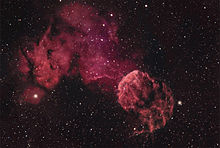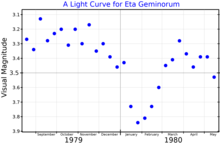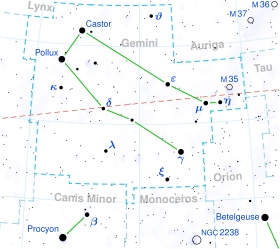Eta Geminorum
| Observation data Epoch J2000.0 Equinox J2000.0 | |
|---|---|
| Constellation | Gemini |
| A | |
| Right ascension | 06h 14m 52.657s[1] |
| Declination | +22° 30′ 24.48″[1] |
| Apparent magnitude (V) | 3.1 – 3.7[2] |
| B | |
| Right ascension | 06h 14m 52.569s[1] |
| Declination | +22° 30′ 24.31″[1] |
| Apparent magnitude (V) | 6.04[1] |
| Characteristics | |
| Spectral type | M2 IIIa[3] (Aa) A[4] (Ab) G0 III[5] (B) |
| Variable type | SRa + EA[6] |
| Astrometry | |
| Proper motion (μ) | RA: −59.530±1.450[7] mas/yr Dec.: −7.766±1.385[7] mas/yr |
| Parallax (π) | 8.48 ± 1.23 mas[8] |
| Distance | approx. 380 ly (approx. 120 pc)[8] |
| Absolute magnitude (MV) | −1.87[9] |
| Orbit[10][4] | |
| Primary | Aa |
| Companion | Ab |
| Period (P) | 8.161 yr |
| Semi-major axis (a) | 0.077″ |
| Eccentricity (e) | 0.5507 |
| Periastron epoch (T) | JD 2444489.1 |
| Argument of periastron (ω) (primary) | 174.20° |
| Semi-amplitude (K1) (primary) | 9.438 km/s |
| Orbit[11] | |
| Primary | A |
| Companion | B |
| Period (P) | 473.7 yr |
| Semi-major axis (a) | 1.08″ |
| Eccentricity (e) | 0.54 |
| Details | |
| Aa | |
| Mass | 5.1[4] M☉ |
| Radius | 275+49 −66[12] R☉ |
| Luminosity | 10,276±4,445[12] L☉ |
| Temperature | 3,502[12] K |
| Metallicity [Fe/H] | +0.04[13] dex |
| Age | 0.81[5] Gyr |
| Ab | |
| Mass | 2[4] M☉ |
| Radius | 1.65[4] R☉ |
| Luminosity | 16[4] L☉ |
| Temperature | 9,000[4] K |
| Other designations | |
| Database references | |
| SIMBAD | data |
Eta Geminorum (η Geminorum, abbreviated Eta Gem, η Gem), formally named Propus /ˈproʊpəs/,[16][14] is a triple star system in the constellation of Gemini. It is a variable star visible to the naked eye, around 380 light years from the Sun.
Nomenclature
[edit]Eta Geminorum is the star's Bayer designation. The traditional names Tejat Prior, Propus (from the Greek, meaning forward foot) and Praepes and Pish Pai (from the Persian Pīshpāy, پیشپای, meaning foreleg). In 2016, the International Astronomical Union organized a Working Group on Star Names (WGSN)[17] to catalog and standardize proper names for stars. The WGSN's first bulletin of July 2016[18] included a table of the first two batches of names approved by the WGSN; which included Propus for this star.
This star, along with γ Gem (Alhena), μ Gem (Tejat Posterior), ν Gem and ξ Gem (Alzirr) were Al Han'ah, "the brand" (on the neck of the camel). They also were associated in Al Nuḥātai, the dual form of Al Nuḥāt, "a Camel's Hump".[15]
In Chinese lunar mansion, Tejat Prior is the only member of the lunar mansion 钺 (Pinyin: Yuè, Chinese 'Battle Axe').[19][15]
Surroundings
[edit]
η Geminorum lies at the foot of the Castor side of Gemini, about two degrees west of μ Geminorum and two degrees southeast of the bright open cluster M35. Between the two stars are several faint areas of nebulosity. η Gem just to the west of the supernova remnant shell IC 443. Further east around μ Gem is the emission nebula S249. In between is the small faint emission nebula IC 444 around the 7th magnitude 12 Geminorum.
η Geminorum is 0.9 degree south of the ecliptic, so it can be occulted by the Moon[20] and, rarely, by planets. The last occultation by a planet took place on July 27, 1910, by Venus,[21] and the next to last on July 11, 1837, by Mercury.[citation needed]
Variability
[edit]
In 1865, Julius Schmidt first reported that η Geminorum was a variable star. The light variations were described by Schmidt and other observers as having long maxima of constant brightness, minima of greatly varying size and shape, and a period around 231 days.[23] The star was classified as both a semiregular variable and an eclipsing variable. The eclipse period has been set at about eight years, corresponding to the orbit of an unseen companion. The eclipses were initially questioned, but special projects led to the eclipses of February 1980, April 1988 and October 2012 being well observed. Eclipses have depths of about half a magnitude and durations of several weeks.[24][22]
The semi-regular variations have been classified as type SRa, indicating relatively predictable periodicity with some variations in amplitude and light curve shape. These types of variable are considered to be very similar to Mira variables, but with smaller amplitudes.[6] Many long-period variables show long secondary periods, typically ten times longer than the main period, but these changes have not been detected for η Geminorum. The main period has been refined to an average of 234 days.[25]
System
[edit]
η Geminorum is a triple system, with the luminous class M star having a close companion known only from radial velocity variations, and a more distant companion resolved visually.
In 1881, Burnham observed that η Geminorum had a close companion (η Gem B). At that time the separation was measured to be 1.08".[26] This has now increased to 1.65" and an orbit has been calculated to be 474 years long and rather eccentric.[23] Little is known about the companion, although it is 6th magnitude. It is given a G0 spectral type and is assumed to be a giant on the basis of its brightness.[5]
In 1902, William Wallace Campbell reported that η Geminorum A showed radial velocity variations. The assumption was that the star was a spectroscopic binary, although no period or other orbital parameters were determined.[27] An orbit calculated in 1944 is essentially unchanged today, with a period of 2,983 days and an eccentricity of 0.53. Observations were made looking for sign of eclipses corresponding to the derived orbit, but the evidence was regarded as inconclusive,[28] and the eclipses were not confirmed until much later. Due to the appearance of the spectrum, the spectroscopic companion is suspected to be a fainter M-class star.[5] Since the secondary star alone would be too small to cause the observed eclipses, it is probably surrounded by a circumstellar disk.[4]
Evolution
[edit]The luminous main component of η Geminorum is an asymptotic giant branch star, a highly evolved cool luminous star that was originally 2-8 M☉ on the main sequence.[29]
Namesakes
[edit]USS Propus (AK-132) was a United States Navy Crater class cargo ship named after the star.
References
[edit]- ^ a b c d e Høg, E.; Fabricius, C.; Makarov, V. V.; Urban, S.; Corbin, T.; Wycoff, G.; Bastian, U.; Schwekendiek, P.; Wicenec, A. (2000). "The Tycho-2 catalogue of the 2.5 million brightest stars". Astronomy and Astrophysics. 355: L27. Bibcode:2000A&A...355L..27H. doi:10.1888/0333750888/2862.
- ^ "VSX : Detail for eta Gem", AAVSO, retrieved 2024-06-25
- ^ Keenan, Philip C.; McNeil, Raymond C. (1989). "The Perkins catalog of revised MK types for the cooler stars". Astrophysical Journal Supplement Series. 71: 245. Bibcode:1989ApJS...71..245K. doi:10.1086/191373. S2CID 123149047.
- ^ a b c d e f g h Torres, Guillermo; Sakano, Kristy (2022). "η Geminorum: An eclipsing semiregular variable star orbited by a companion surrounded by an extended disc". Monthly Notices of the Royal Astronomical Society. 516 (2): 2514–2521. arXiv:2208.07375. Bibcode:2022MNRAS.516.2514T. doi:10.1093/mnras/stac2322.
- ^ a b c d Hunsch, Matthias; Schmitt, Jurgen H. M. M.; Schroder, Klaus-Peter; Zickgraf, Franz-Josef (1998). "On the X-ray emission from M-type giants". Astronomy and Astrophysics. 330: 225. Bibcode:1998A&A...330..225H.
- ^ a b Samus, N. N.; Durlevich, O. V.; et al. (2009). "VizieR Online Data Catalog: General Catalogue of Variable Stars (Samus+ 2007-2013)". VizieR On-line Data Catalog: B/GCVS. Originally Published in: 2009yCat....102025S. 1. Bibcode:2009yCat....102025S.
- ^ a b Brown, A. G. A.; et al. (Gaia collaboration) (August 2018). "Gaia Data Release 2: Summary of the contents and survey properties". Astronomy & Astrophysics. 616. A1. arXiv:1804.09365. Bibcode:2018A&A...616A...1G. doi:10.1051/0004-6361/201833051. Gaia DR2 record for this source at VizieR.
- ^ a b van Leeuwen, F. (2007-11-01). "Validation of the new Hipparcos reduction". Astronomy and Astrophysics. 474 (2): 653–664. arXiv:0708.1752. Bibcode:2007A&A...474..653V. doi:10.1051/0004-6361:20078357. ISSN 0004-6361.
- ^ Ryon, Jenna; et al. (August 2009). "Comparing the Ca ii H and K Emission Lines in Red Giant Stars". Publications of the Astronomical Society of the Pacific. 121 (882): 842. arXiv:0907.3346. Bibcode:2009PASP..121..842R. doi:10.1086/605456. S2CID 17821279.
- ^ Malkov, O. Yu.; Tamazian, V. S.; Docobo, J. A.; Chulkov, D. A. (2012). "Dynamical masses of a selected sample of orbital binaries". Astronomy & Astrophysics. 546: A69. Bibcode:2012A&A...546A..69M. doi:10.1051/0004-6361/201219774.
- ^ Tokovinin, A. A. (1997). "MSC - a catalogue of physical multiple stars". Astronomy and Astrophysics Supplement Series. 124: 75–84. Bibcode:1997A&AS..124...75T. doi:10.1051/aas:1997181.
- ^ a b c Baines, Ellyn K.; Thomas Armstrong, J.; Clark, James H.; Gorney, Jim; Hutter, Donald J.; Jorgensen, Anders M.; Kyte, Casey; Mozurkewich, David; Nisley, Ishara; Sanborn, Jason; Schmitt, Henrique R. (November 2021). "Angular Diameters and Fundamental Parameters of Forty-four Stars from the Navy Precision Optical Interferometer". The Astronomical Journal. 162 (5): 198. arXiv:2211.09030. Bibcode:2021AJ....162..198B. doi:10.3847/1538-3881/ac2431. ISSN 0004-6256. S2CID 238998021.
- ^ Huang, Y.; Liu, X.-W.; Yuan, H.-B.; Xiang, M.-S.; Chen, B.-Q.; Zhang, H.-W. (2015). "Empirical metallicity-dependent calibrations of effective temperature against colours for dwarfs and giants based on interferometric data". Monthly Notices of the Royal Astronomical Society. 454 (3): 2863. arXiv:1508.06080. Bibcode:2015MNRAS.454.2863H. doi:10.1093/mnras/stv1991. S2CID 118487917.
- ^ a b "IAU Catalog of Star Names". Retrieved 28 July 2016.
- ^ a b c Allen, Richard Hinckley (1963) [1899]. Star Names: Their Lore and Meaning. New York, NY: Dover Publications. ISBN 0-486-21079-0 – via LacusCurtius.
- ^ Kunitzsch, Paul; Smart, Tim (2006). A Dictionary of Modern star Names: A Short Guide to 254 Star Names and Their Derivations (2nd rev. ed.). Cambridge, Massachusetts: Sky Pub. ISBN 978-1-931559-44-7.
- ^ "IAU Working Group on Star Names (WGSN)". Retrieved 22 May 2016.
- ^ "Bulletin of the IAU Working Group on Star Names, No. 1" (PDF). Retrieved 28 July 2016.
- ^ (in Chinese) AEEA (Activities of Exhibition and Education in Astronomy) 天文教育資訊網 2006 年 5 月 26 日 Archived 2011-05-21 at the Wayback Machine
- ^ White, Nathaniel M.; Feierman, Barry H. (September 1987). "A Catalog of Stellar Angular Diameters Measured by Lunar Occultation". Astronomical Journal. 94: 751. Bibcode:1987AJ.....94..751W. doi:10.1086/114513.
- ^ Können, G. P.; Van Maanen, J. (April 1981). "Planetary occultations of bright stars". Journal of the British Astronomical Association. 91: 148–157. Bibcode:1981JBAA...91..148K.
- ^ a b "Variable Star of the Year 2012" (PDF). Retrieved August 12, 2016.
- ^ a b Hassforther, B. (2007). "Eta Geminorum - wirklich ein Bedeckungsveraenderlicher?". BAV Rundbrief. 56: 205. Bibcode:2007BAVSR..56..205H.
- ^ "The 2004 eclipse of Eta Geminorum" (PDF). Retrieved August 12, 2016.
- ^ Percy, J. R.; Nasui, C. O.; Henry, G. W. (2008). "Long-Term Photometric Variability of 13 Bright Pulsating Red Giants". The Journal of the American Association of Variable Star Observers. 36 (1): 139. Bibcode:2008JAVSO..36..139P.
- ^ Clerke, A. M. (1902). "The system of eta Geminorum". The Observatory. 25: 389. Bibcode:1902Obs....25..389C.
- ^ Campbell, W. W. (1902). "Six stars whose velocities in the line of sight are variable". Astrophysical Journal. 16: 114. Bibcode:1902ApJ....16..114C. doi:10.1086/140954. S2CID 123054295.
- ^ McLaughlin, Dean B.; Van Dijke, Suzanne E. A. (1944). "The Spectrographic Orbit and Light-Variations of η Geminorum". Astrophysical Journal. 100: 63. Bibcode:1944ApJ...100...63M. doi:10.1086/144637.
- ^ Eggen, Olin J. (1992). "Asymptotic giant branch stars near the sun". Astronomical Journal. 104: 275. Bibcode:1992AJ....104..275E. doi:10.1086/116239.

